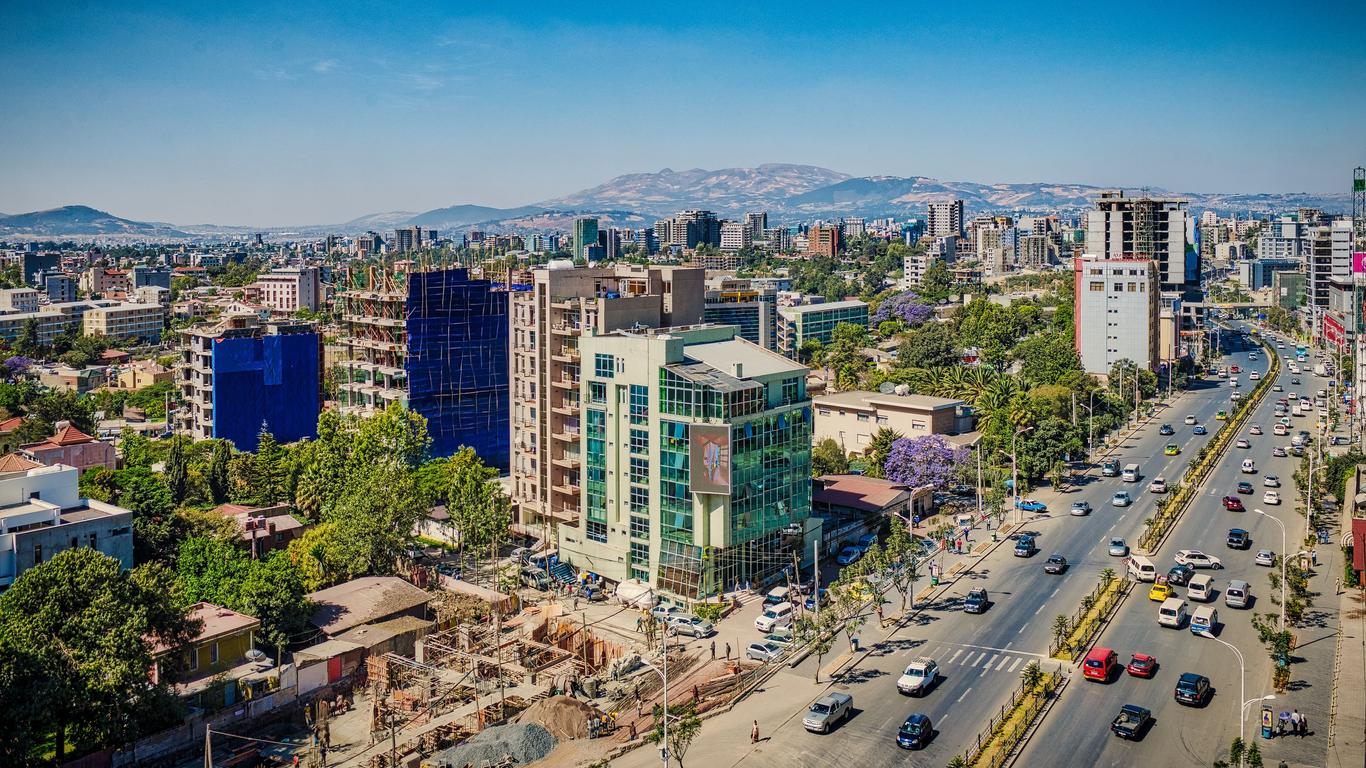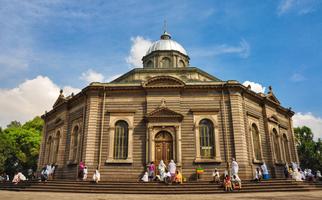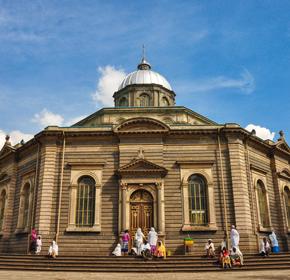
Addis Ababa travel guide
Addis Ababa Tourism | Addis Ababa Guide
You're Going to Love Addis Ababa
One of Africa's most important cities, Addis Ababa is home to nearly 3.5 million people. Sitting atop the highlands next to the Great Rift Valley, the city sprawls over more than 200 square miles, housing a startling variety of historical and cultural attractions. And, if you want to get out, there are the massive Entoto Mountains to explore right above Addis Ababa.
Within the city center, Addis Ababa boasts monumental architecture and all of the grandeur that can be expected from any national capital. Great churches, mosques, and museums offer respite, solace, education, and inspiration to travelers from around the world. Meanwhile, traditional Ethiopian food and dance are on constant display throughout the city.
Addis Ababa, while cosmopolitan, is still a place where authentic Ethiopian culture is on full display. Whether you're drawn by its history, its art, or its cuisine, there's plenty to be surprised by here.
Top 5 Reasons to Visit Addis Ababa
1. Fantastic Museums
Those who are unfamiliar with Ethiopian culture, as well as its avid admirers, often enjoy the many museums of Addis Ababa. The National Museum of Ethiopia, for example, is a world-class establishment featuring artifacts from Ethiopia's storied ancient civilization to today. More recent history is displayed at the Red Terror Martyrs' Memorial Museum, which chronicles the famine of the 1990s and is staffed by survivors of state atrocities.
2. Religious Architecture
Like many capitals, Addis Ababa is home to people of many faiths, and numerous grand churches and mosques fill the cityscape. St. George's Cathedral is known for its beautiful paintings and mosaics, while the Anwar Mosque impresses with its size.
3. Entoto Mountain Hike
Mount Entoto towers over the city and the surrounding landscape. Those looking to drink in a special view are encouraged to plan a day hike up to the summit, which should take about half a day. Additionally, it is possible to take a taxi to the summit for under Br300.
4. Amazing Cuisine
Ethiopian food is delicious, rich, and unique. The national dish features injera, an unleavened bread that is spongy and slightly reminiscent of sourdough. Various stewed meats and vegetables are served on top of injera, and no utensils are used - just scoop the food in the injera and enjoy!
5. Bustling Markets
Ethiopian crafts and clothing are beautiful, and Addis Ababa is a great place to buy them. Many of the city's markets offer hours of entertainment, if only because of the widespread practice of haggling with sellers.
What to do in Addis Ababa
1. Mount Entoto: Sacred Mountain, Soulful People
Arguably the birthplace of humanity, the secret of Ethiopia as one of the world's most interesting but least known travel destinations is finally getting out, due to a booming economy to match the country's immense natural, cultural, and historical wonders. Boasting elegant new hotels, amazingly good restaurants and a host of major infrastructure improvements, the capitol city of Addis Abada is an adventurer's gateway to exotic landscapes, incredible wildlife, the most UNESCO World Heritage Sites in Africa, and some of the world's friendliest, most beautiful people. For many, the adventure begins on a minibus to the breathtaking heights of Mount Entoto, which rises 10,499 feet over Addis Abada amid a dense forest of eucalyptus trees. Historically significant because it was the palatial home of Emperor Menelik II, the founder of modern Ethiopia, the mountain's many monasteries and celebrated churches quietly affirm its reputation as a sacred place.
2. Arada Giyorgis: Venerable St. George's
Founded in the 4th century, the Ethiopian Orthodox Church is one of the world's oldest Christian churches, and represents more than two-third's of the country's 100 million inhabitants. Some of that heritage can be traced to the octagonal-shaped, gray-stone exterior of St. George's Cathedral, which dates back to the 15th century. A pilgrimage site for Rastafarians, the church has seen Ethiopian royalty crowned and torch fires set by Italian fascists in the 1937 war. Ornately cloaked in paintings and mosaics, the Piazza cathedral's compelling history is outlined with many religious artifacts at its museum.
3. Addis Mercato: The Mall Was Never Like This
Sidestep the heavily-laden donkeys and the quick-footed porters carrying humongous odd-sized loads on their head at Addis Mercato, a mass of people, stalls, and goods thoroughly engaged in free enterprise - until everything stops as a herd of goats cross the road. Reputed to be Africa's largest market, offering everything from pungent Ethiopian spices and the world's best coffee to silver jewelry and shoe shines, the mercato is an unforgettable experience. Few places provide an opportunity to find some order and beauty in what looks like unmitigated chaos.
4. Meskel Square: Take a Cab, Please Take a Cab
The site of a 1,600 year-old spring festival, as well as countless public gatherings and demonstrations, Meskel Square is Addis' largest square and a prime location for people watching, including those aspiring Olympian runners who train there. See it but don't drive there. With no traffic lights, no roundabout and nary a cop in sight, it may be the most insane intersection on the planet.
5. National Museum of Ethiopia: Lucy On The Ground With Diamonds
Lucy, who was named for a Beatles song, lived near Addis Ababa 3.2 million years ago, spending most of her time in the trees. When she hit the ground to forge for food she would walk on two upright legs, a trait that could make Lucy - whose well-preserved, fossilized skeleton is held at the National Museum - our oldest direct human ancestor.


1. Mount Entoto: Sacred Mountain, Soulful People
Arguably the birthplace of humanity, the secret of Ethiopia as one of the world's most interesting but least known travel destinations is finally getting out, due to a booming economy to match the country's immense natural, cultural, and historical wonders. Boasting elegant new hotels, amazingly good restaurants and a host of major infrastructure improvements, the capitol city of Addis Abada is an adventurer's gateway to exotic landscapes, incredible wildlife, the most UNESCO World Heritage Sites in Africa, and some of the world's friendliest, most beautiful people. For many, the adventure begins on a minibus to the breathtaking heights of Mount Entoto, which rises 10,499 feet over Addis Abada amid a dense forest of eucalyptus trees. Historically significant because it was the palatial home of Emperor Menelik II, the founder of modern Ethiopia, the mountain's many monasteries and celebrated churches quietly affirm its reputation as a sacred place.
2. Arada Giyorgis: Venerable St. George's
Founded in the 4th century, the Ethiopian Orthodox Church is one of the world's oldest Christian churches, and represents more than two-third's of the country's 100 million inhabitants. Some of that heritage can be traced to the octagonal-shaped, gray-stone exterior of St. George's Cathedral, which dates back to the 15th century. A pilgrimage site for Rastafarians, the church has seen Ethiopian royalty crowned and torch fires set by Italian fascists in the 1937 war. Ornately cloaked in paintings and mosaics, the Piazza cathedral's compelling history is outlined with many religious artifacts at its museum.
3. Addis Mercato: The Mall Was Never Like This
Sidestep the heavily-laden donkeys and the quick-footed porters carrying humongous odd-sized loads on their head at Addis Mercato, a mass of people, stalls, and goods thoroughly engaged in free enterprise - until everything stops as a herd of goats cross the road. Reputed to be Africa's largest market, offering everything from pungent Ethiopian spices and the world's best coffee to silver jewelry and shoe shines, the mercato is an unforgettable experience. Few places provide an opportunity to find some order and beauty in what looks like unmitigated chaos.
4. Meskel Square: Take a Cab, Please Take a Cab
The site of a 1,600 year-old spring festival, as well as countless public gatherings and demonstrations, Meskel Square is Addis' largest square and a prime location for people watching, including those aspiring Olympian runners who train there. See it but don't drive there. With no traffic lights, no roundabout and nary a cop in sight, it may be the most insane intersection on the planet.
5. National Museum of Ethiopia: Lucy On The Ground With Diamonds
Lucy, who was named for a Beatles song, lived near Addis Ababa 3.2 million years ago, spending most of her time in the trees. When she hit the ground to forge for food she would walk on two upright legs, a trait that could make Lucy - whose well-preserved, fossilized skeleton is held at the National Museum - our oldest direct human ancestor.


Where to Eat in Addis Ababa
Ethiopian restaurants can be found throughout town, as can international cuisine. Atelefugne Bar serves great local dishes for less than Br50. Meanwhile, dinner and a show await at Bole Mini, and YOD Abyssinia also dishes up highly rated local food.
When to visit Addis Ababa
Addis Ababa enjoys a fairly temperate subtropical highland climate, which varies from district to district because the elevation of the city ranges from around 7,500 feet above sea level to nearly 10,000 feet. Summer temperatures peak at about 80 degrees, while winter averages don't dip far below 60 during the day. However, there can be a great deal of variation within one day due to the elevation, so nightfall can bring much lower temperatures.
How to Get to Addis Ababa
Plane
Addis Ababa Bole International Airport (ADD) is one of the busiest on the continent and sees daily flights to Europe, Asia, and America, as well as African destinations. The airport is not far from the city center and is accessible from the Ring Road. Many taxis can be found on-site for around Br200 and not more than Br300. Additionally, many hotels offer free shuttle service to the airport.
Train
A brand-new (as of 2017) electric rail line connects Addis Ababa to Djibouti. If traveling in this direction, note that the train takes less than 12 hours, whereas driving takes three days. This train leaves from Furi-Labu station.
Car
Ethiopia's roads are well-maintained and a safe way to explore the country. Addis Ababa connects to the rest of the country through many highways: the 1, the 5, the 51, the 4, the 3, and the 2. However, if you rent a car, you need a driver. An old compact car will cost about Br2700 for one day.
Bus
Addis Ababa is home to three bus terminals: Autobus Terra, Meskel Square, and ASCO. Buses connect to multiple domestic and international destinations and are a safe and affordable way to travel.
Airports near Addis Ababa
Airlines serving Addis Ababa
Where to stay in Addis Ababa
Bole - the Bole area is one of the wealthier parts of town, home to affluent locals and foreigners who work for one of the 120+ international missions, embassies, and NGOs based in the city. Expect to find good restaurants in this area.
Popular Neighborhoods in Addis Ababa
Kirkos - this central district is home to the National Palace, Africa Hall, and Meskel Square, some of the more important civic areas in the city.
Arada - home to many of the city's most famous museums as well as many of the campuses of Addis Ababa University, this sprawling district is a great place to walk around and stop in at various institutions to explore Ethiopian culture.
Where to stay in popular areas of Addis Ababa
Most booked hotels in Addis Ababa
How to Get Around Addis Ababa
Public Transportation
Addis Ababa just opened a light rail transportation system that runs through much of the city and operates seven days a week. Tickets cost Br2-6 and all destinations are marked in English as well as Amharic. Minibuses are also a great way to get around, and are often very cheap. You can hail a minibus anywhere that it is safe to stop. Inside, the conductor will call out the destination, and if it is yours, get in and pay when requested. Usually, minibuses cost between Br2 and Br7.
Taxi
Taxis are also easy to find, and prices for an average trip range from Br80 to Br120.
Car
As mentioned above, it is possible to rent a car in Addis Ababa. That being said, traffic can be very hectic, and many major intersections, including Meskel Square, do not have stoplights. A car and driver can be rented for about Br600 a day.
The Cost of Living in Addis Ababa
Shopping Streets
The most famous market in Addis Ababa is Mercato. It is a covered market dating back to the 1930s offering everything from t-shirts to manufacturing goods. Haggling is the name of the game, and if you are good at it, you can get traditional clothing for around Br100.
Groceries and Other
Supermarkets and convenience stores dot the city, although there is no dominant chain. You can expect to buy apples at Br40 a pound, while bread costs just Br8 per loaf.

